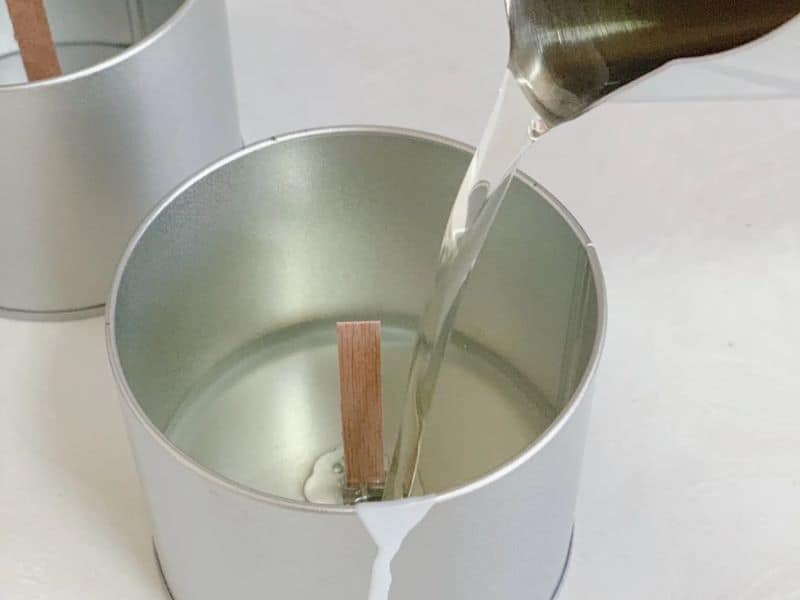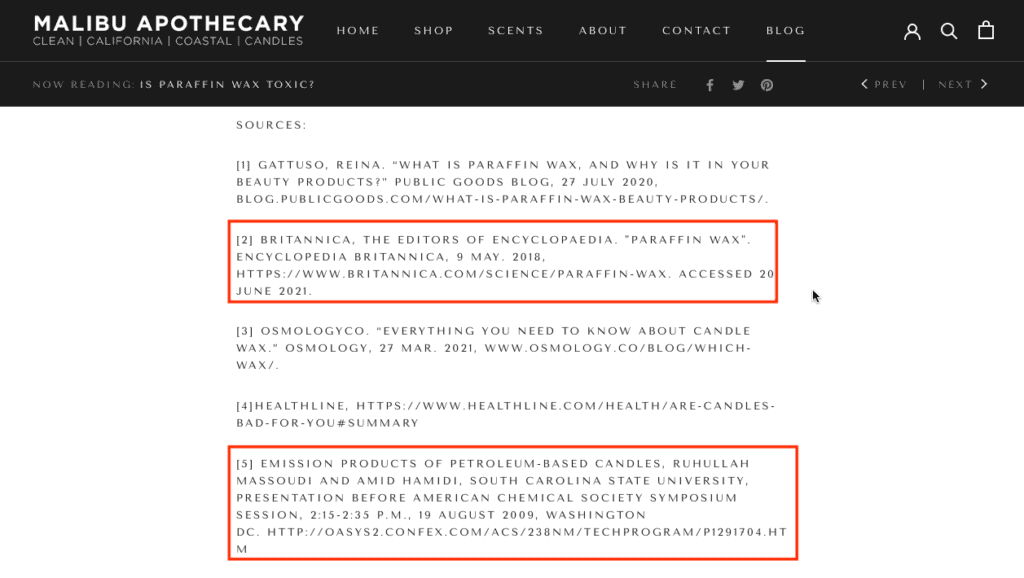It may sound like opposite ends of the wax spectrum, but you can mix soy and paraffin wax.
Although one is considered toxic, and the other one natural, there are a number of reasons why blending them makes sense. Paraffin wax can add structure to soy wax, make its fragrance stronger, and prevent the lumpy texture that can appear on the surface of pure soy candles.
If you’ve been trying to troubleshoot various challenges related to making 100% soy candles, then blending in paraffin wax might be a solution worth considering. Continue reading to discover if this is the right wax blend for you.

Why Mix Soy and Paraffin Wax?
Completely natural soy wax is difficult to work with. Blending it with paraffin can produce a versatile wax blend. Blending these two waxes can be surprisingly beneficial. Here are some ways mixing soy and paraffin wax can lead to less complicated candle making:
Structure
Soy wax is too soft to effectively produce useful pillar and other molded candles. Typically, soy candles are poured into containers for this very reason. If you were to blend soy and paraffin wax, you would be able to create molded candles without a problem.
Fragrance
All soy wax has a weak cold and hot fragrance throw. The exception is if you’re using essential oils. Fragrance from essential oils tends to remain strong when added to 100% soy candles. But fragrance oils are a different story.
Paraffin wax has a very strong fragrance throw and works well with fragrance oils blended with essential oils.
If you mix soy and paraffin wax, it’ll result in a candle made with some natural ingredients and an irresistible scent. That’s why companies like Bath & Body Works combine soy and premium paraffin wax.
Unattractive Surface
When using 100% soy candles, you might experience sunken holes on the surface of the candle. Rough lumps also appear upon cooling. Air bubbles and surface cracks create frustration for candle makers using only soy wax as well.
With soy wax you have to be more mindful of pour temperatures and air bubbles. You can troubleshoot these problems, but it’s helpful not to have to go through the pouring process more than once.
Soy wax blended with paraffin produces smooth, silky surfaces once the candle has cooled.
Frosting
Nope, not taking about cake here. Because soy wax is all natural, small crystals can grow on its surface and sides. This collection of crystals is referred to as frosting.
It’s more visible on candles that have been colored. While it doesn’t interfere with burn time or fragrance, it’s simply unattractive even though soy candle color is less vibrant. On way to prevent frosting is to warm your containers prior to pouring in the soy wax. Frosting doesn’t occur when paraffin wax is blended in.
Coloring
Paraffin wax takes pigment exceptionally well; soy wax does not. If you want to make candles that have rich, saturated hues, you’ll have to blend soy with another wax. And since paraffin takes color so well, it’d be a good match for colorful candles.
Mixing soy and paraffin wax not only adds vibrancy to the color of soy candles, it also prevents them from developing those annoying crystals that are more obvious on colored candles. Mixing in paraffin wax is one preventive measure.
Poor Adherence
Another challenge with all natural soy candles is that they don’t always adhere to the wall of their container.
Since these gaps or wet spots are only visible in transparent glass containers, it may help to heat them before pouring in your wax. Poor adherence is also the result of uneven cooling. This happens when some portions of the candle wax cool off faster than others. In addition to preventing poor adherence, preheating your glass containers can help to create conditions that allow for even cooling.
Or, you can mix in paraffin wax and avoid this altogether.
Texture
Paraffin wax alone looks, well, waxy. When combined with the creaminess of soy wax, you’ll get a candle with a smooth, velvety texture. This makes for a more attractive candle.
But Wait, Isn’t Paraffin Wax Toxic?
Soy wax is one of the most popular eco-friendly candle wax options. Paraffin is often pitted against soy wax, described as a toxic wax that produces black smoke and releases carcinogens into the air when burned.
All of the statements made in the video below align with this old narrative about paraffin wax:
The allegations against paraffin wax are that it’s not sustainable, it generates toxic black smoke, and it releases toxic carcinogens in the air when lit.
But these claims have not been substantiated by any reputable school or organization. A southern university released research results claiming that paraffin wax is harmful, but that article has since been removed.
You can see here on the United States Department of Agriculture website that the same university’s investigation into this matter was terminated in 2010.
But individuals like the woman above and candle companies still reference the research results presented by this school as if it’s factual information.
Research projects take years and lots of resources – time, money, lab equipment, and so forth. There has to be a reason why results from a terminated USDA research project were removed from the university website.
Even one of the articles that the candle company above referenced, has been removed from the Encyclopedia Britannica website. Reference number 5 has been removed from the American Chemistry Society conference website as well.
The claim that burning candles made with paraffin wax releases toxins in the air has yet to be published to a peer-reviewed journal, which is the standard for such a declaration. European Candle Association (ECA) released this statement countering the university’s claim. The USA-based National Candle Association supports this position.
ECA referenced an internationally funded study testing soy, paraffin, beeswax, palm wax and stearin. These waxes “…pose no discernable risks to human health or indoor air quality.”
All of them burned cleanly and safely. Meaning, you aren’t inhaling toxic smoke when burning candles, not even those made with paraffin wax.
Then Why Do Paraffin Candles Produce Black Smoke?
Paraffin candles don’t produce any more black smoke than a candle made with a different kind of wax.
Black smoke can be caused by a lot of things. Decades ago, wicks made with a lead core were banned in the United States. Those wicks were actually releasing toxic black smoke.
Most candle companies no longer use wicks with any kind of metal core. Now that they’re no longer used, we can pay attention to other contributing factors.
What Causes Candles to Produce Black Smoke?
Some problems with black smoke stem back to how the candle was made. Then there are other reasons caused by the candle owner that can also make the candle soot.
Wrong Wick Size – Choosing the wrong wick size can produce black smoke. On the production side, wicks that are too large cause candles to burn too quickly. Large flames result, causing release of black smoke and soot.
Too Much Fragrance Oil – Even with a 100% natural soy candle, adding a higher fragrance load than the wax can handle can lead to black smoke. In this case, the excess oil is burning along with the wax.
Improper Candle Care – Some people don’t take seriously the need to trim candle wicks. But if a candle wick isn’t trimmed to ¼ inch, the flame can rise too high, burn too quickly, and then release streams of black smoke into the air.
Improper Ventilation – It also helps to burn candles in well-ventilated areas. BUT, you don’t want to burn candles in the direct path of strong winds or heating and cooling vents in the home. This causes the flame to dance around, get out of hand, and produce black smoke.
Blowing Out Candles – The international study mentioned above was eventually published in a peer-reviewed journal. In it, the authors suggest that you smolder your candles, like with a candle snuffer, instead of blowing them out. Using a snuffer further reduces exposure to soot particles, even though exposure is miniscule in the first place.
Takeaway: While paraffin wax isn’t a renewable resource, it does not release toxic carcinogens, either. If a paraffin candle produces black smoke, there could be many other reasons why that happens. Soot particles can be produced by any form of combustion; it’s not specific to paraffin wax.
Should You Mix Soy and Paraffin Wax?
Whether you’re making candles for yourself, as gifts, or to sell, deciding which products to use is a complex, but personal process.
No one can tell you what will work best for you or your business. But with the information covered here, I’m sure that you can see that there are many reasons why mixing soy and paraffin wax could be beneficial.
You can safely mix paraffin and soy wax to make candles that burn well, have a strong fragrance, and an aesthetically pleasing surface.
Read more:

